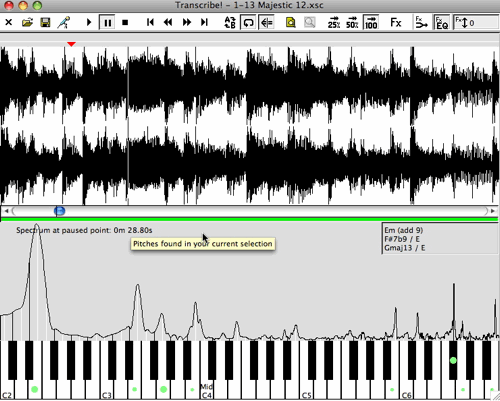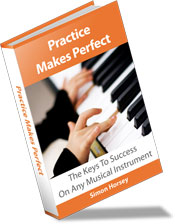The meaning of Transcribe Music
There are two meanings to the phrase transcribe music. Classical musicians may sometimes refer to 'transcribing music for certain instruments' e.g. if you were to transcribe an orchestral piece for the piano. When used in this way it basically means the same as arrange.
The other, more common meaning is the process of writing a piece of music down from a recording. That is what this page deals with... the process of transcribing a piece of music from hearing it.
Why are you transcribing?
This could be because a teacher told you to! It is more likely however that you have chosen to transcribe music because there is something you have heard which you want to play. For me it was always jazz solos and before the internet it was hard to search for the sheet music. Transcribing music was often the only way!
It is much easier to find copies of sheet music now - the relentless march of technology is making me feel old here! Unless you are transcribing a piece for a particular reason check and see if the music is available anywhere. Music transcription is a valuable skill, but there are plenty of pieces for which there is no sheet music available! If the music is available consider getting at least a lead sheet containing the melody and chords, especially if this is your first attempt to transcribe music! Follow through the score with the music and add any extra notes or changed timings you hear. Jazz musicians especially, are fond of substituting different chords or embellishing melodies and rhythms. You will still have plenty to do!
Another option is to pick you favourite section of the music and transcribe that, instead of working on the whole piece. Start slowly in small sections, just like practice! And I'm sure you've guessed already...your ability to transcribe music gets better with practice!
The process of transcribing music
The process of transcribing music
Assuming you have decided to transcribe a piece of music or a section, here are the steps to follow.
If possible use your instrument I can
transcribe music away from the keyboard (i do have perfect pitch
though, which is a considerable help) but why torture myself? It is much easier
to transcribe music with your instrument, especially if you play piano
or to some extent, guitar, since these can help with the chords later as
well.
Get hold of some software such as Transcribe! or a CD player that allows you to loop sections of a piece. If you have a Mac GarageBand
can easily be used to loop audio, although you can't alter the speed of
the audio. If it allows you to slow the music down without altering the
pitch as well that is an added bonus! Talking of pitch, it is also very
helpful if either the CD player , software or your instrument can be
tuned up or down slightly to ensure the recording and the instrument are
exactly in tune.
Map the structure of the piece or section, including the timings.
It really helps to have an overall idea of how the piece fits together.
I always write the chords down as early as possible. Listen to the
piece several times. Is there a recognisable standard chord pattern such
as the 12 Bar Blues or the Rhythm Changes?Having an
overview, including key changes etc. helps predict where the melody or
harmony goes. On a more practical level, knowing the overall structure
of a piece also means that if a particular phrase is hard to hear in one
section, you may be able to hear it in a later, repeated section.
Work outside in
In the same way you start outside a house and go into the reception
room then into further rooms you should begin transcribing music in the
same way. Start with the melody and the bass part. Being on the outside
and furthest apart, these are the easiest to hear. Once you have the
chords, melody and bass it makes it easier to work out the inner parts.
If you are having difficulty with transcribing the rhythm
write the beats (and sub-beats if needed) for each bar and count them
out loud as you listen to the melody. Each time there is a melody note
place a dot in the appropriate position in the bar. This is much quicker
than writing notes for beginners. See the illustration below. This is
for Mozart's Eine Kleine Nachtmusik. You can see where the dots come and how I have converted this into the rhythm above the dots.

E.g. The first dot comes on the first beat and the second comes on
the second half of the second beat. This means the first is one and a
half beats long. The third dot comes on the third beat meaning the
second note must be a quaver. This is not infallible because it doesn't
easily take account of rests. The end of the second bar could be a
crotchet and a crotchet rest, or a minim, but once you have a rough idea
of the rhythm it is easier to go through and listen to specific spots
like this.
Listen carefully. Do the easy bits first. Leave
gaps to be filled later. Get down what you can of the middle parts then
start analysing the piece and working out the possibilities for the
inner parts. If some are totally impossible to hear...make something up
using the chords and the parts you have already. With a little
experience your educated guesses can often be correct! Try to hear the
top note of each chord and determine the voicing from there. It is also
worth thinking about voice leading, i.e. how each note within the chord
moves to the same position in the following chord.
Transcribing music is basically like completing a puzzle. Just find where each piece goes, fit them all together, patiently, and you will end up with a written version of the piece. It isn't easy - but it can be very rewarding...and it improves your ability in improvisation and composition no end!
Music transcription software
There are two different types of music transcription software.
The first is an automatic music transcriber. You drag an audio file into the transcriber software and the software converts the audio file into written music...if only such a piece of software existed! There are a few that make the claim, most notably Intelliscore. Intelliscore takes the audio file and converts it to a MIDI file. Once you have the music in MIDI format it can be opened in any editor such as Sibelius and the notes edited or score printed. However, from reading actual, real-world reviews such as this review of Intelliscore on emusician, it seems the results are haphazard at best. I'm also sure that if it really worked totally as advertised everyone would have already heard of it and the first, and only text on this page would be "buy intelliscore" and a link to their site. I'd probably make it an affiliate link too since if it really did work on all music the cost would be more than the $79.99 they charge for a download!
The second (and more realistic) type of software to help you transcribe music slows the music down, while retaining the correct pitch and loops it, allowing you to hear the individual parts more easily. There are a few programs in this category but only one that really counts and a close runner up as far as I am concerned. My main choice of software for transcribing music is, funnily enough called, Transcribe!
I have found Transcribe! to be the best music transcription software and often use it for intricate sections of music I need to transcribe. I find it especially handy when working out fast right hand piano runs (using the slow down function) and determining the voicing of left hand chords (using the keyboard and suggested chords feature).
Update: Transcribe has been updated with a new look and even more functionality! I opened it to use today while transcribing a four part choir piece and was pleasantly surprised when the update downloaded with a whole new look, including a new 70% speed button, which I find the most useful and move to 50% if there is a particularly difficult part. I am preparing a full review of the new version and it will be up shortly!
Here is a screen shot of Transcribe! in action.

If you want to read more about Transcribe! click the image above or click here you wish to buy now and go directly to the order page.
Interestingly Seventh String software, makers of Transcribe! even have links to other similar(ish) software on their site so you can try any of the others if you want to...but you can take it from me. Don't waste your time. I went through quite a few on the list and none of them lived up to Transcribe!
Slowing music down
If all you need when you transcribe music is to slow down the music this can be done for free in Quicktime and Windows Media Player. Check out the Slow Down Music page for more details and a downloadable instructions sheet.
And if you have the cash...
Melodyne is now able to break up audio files into individual notes and change them, as well as slowing down music to an almost dead stop without affecting pitch, although I don't think there is a particular function that will transcribe music...yet! This does makes it much easier to find the notes in a particular chord though! I have only seen it demonstrated on individual instruments so I'm not sure how it would work on music with lots of different timbres...however, if it can't yet - it won't be long! Check out some of the videos on YouTube, or Google Melodyne and be seriously impressed. Not necessarily a true resource to transcribe music, or a serious practice tool yet...but it's on my shopping list! This is a very exciting time for manipulation of audio!
Transcribe music: Conclusions
While it is exciting to think that computers may be able to deconstruct audio files before long, and even alter their contents, the fact still remains that the ability to transcribe music is a great asset when it comes to understanding particular styles of music and musicians better. Composers from Bach, Mozart and Beethoven to jazz stars such as Herbie Handcock, Chick Corea and Courtney Pine cut their teeth transcribing the works of other great musicians. It can be a slow process, but one which improves with practice. Start small and give it a try. You, and your audiences, will never regret it!
Expert Practice Secrets
Frustrated with your practice? Read Practice Makes Perfect and hack the 10,000 hour rule. Cut your practice time by up to 25%! Make faster progress, learn pieces and scales faster, memorize more easily, and much more. "If you play an instrument you need this book!"
Recent Articles
-
How To Speed Up Scales and Improve Accuracy
Oct 13, 24 04:23 AM
How to speed up scales is something many people want to know, but speed should also come with accuracy. Read on to find out how to do both. -
From an opera singer, on her death bed to Leonard Bernstein
Jan 29, 24 03:36 PM
I enjoy reading the music more than hearing it. From an opera singer, on her death bed to Leonard Bernstein -
unknown
Jan 29, 24 02:52 PM
Not happy with your tone? Practice more.

New! Comments
Have your say about what you've just read!Leave me a comment in the box below.